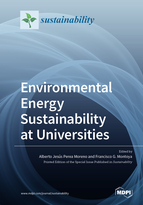Environmental Energy Sustainability at Universities
A special issue of Sustainability (ISSN 2071-1050). This special issue belongs to the section "Energy Sustainability".
Deadline for manuscript submissions: closed (30 September 2020) | Viewed by 41203
Special Issue Editors
Interests: renewable energy; energy saving; biomass; sustainability; remote sensing
Special Issues, Collections and Topics in MDPI journals
Interests: geometric algebra; power quality; power theory; power engineering; optimization techniques
Special Issues, Collections and Topics in MDPI journals
Special Issue Information
Dear Colleagues,
We are inviting submissions to a Special Issue of Sustainability on the topic “Environmental Energy Sustainability at Universities”.
The use of renewable energies and energy saving and efficiency are needs of global society and universities. Universities have a large responsibility and social impact, as they are an example and engine of social change. Universities, in the European context, must be at the forefront of ESA processes, seeking to be at the same level, and preferably higher than the rest of society, seeking the goal of 20% in renewable energy for 2020 and, in the longer term, greater energy efficiency based on a diverse use of renewable energy and studying the feasibility of other energy processes (cogeneration, trigeneration, etc.). The application of renewable energies and efficiency allow universities to make significant savings in their costs, and contribute to sustainable development and the fight against climate change. Actions on these aspects in addition to the objective of saving should seek to promote research and form an example for the university community. This Special Issue aims to advance the contribution of energy saving and the use of renewable energies in order to achieve more sustainable universities. This Special Issue seeks contributions spanning a broad range of topics related but not limited to:
- Solar energy
- The use of rooftops for energy generation
- Energy conversion from urban biomass or residues
- Energy management for sewage water
- Bioclimatic architecture and green buildings
- Wind energy cogeneration
- Public and private urban energy saving
- Policy for urban energy saving
- Electric meters
- Zero-energy buildings
I believe that this Special Issue will help promote sustainability at universities.
Thank you for your contributions.
Prof. Dr. Alberto Jesús Perea Moreno
Prof. Dr. Francisco G. Montoya
Guest Editors
Manuscript Submission Information
Manuscripts should be submitted online at www.mdpi.com by registering and logging in to this website. Once you are registered, click here to go to the submission form. Manuscripts can be submitted until the deadline. All submissions that pass pre-check are peer-reviewed. Accepted papers will be published continuously in the journal (as soon as accepted) and will be listed together on the special issue website. Research articles, review articles as well as short communications are invited. For planned papers, a title and short abstract (about 100 words) can be sent to the Editorial Office for announcement on this website.
Submitted manuscripts should not have been published previously, nor be under consideration for publication elsewhere (except conference proceedings papers). All manuscripts are thoroughly refereed through a single-blind peer-review process. A guide for authors and other relevant information for submission of manuscripts is available on the Instructions for Authors page. Sustainability is an international peer-reviewed open access semimonthly journal published by MDPI.
Please visit the Instructions for Authors page before submitting a manuscript. The Article Processing Charge (APC) for publication in this open access journal is 2400 CHF (Swiss Francs). Submitted papers should be well formatted and use good English. Authors may use MDPI's English editing service prior to publication or during author revisions.
Keywords
- Energy saving
- renewable energy
- universities
- zero-energy buildings
- energy efficiency
- sustainability
- bioclimatic architecture
- sustainable transport
- PV
- CSP
- energy saving in laboratories
- energy saving in data processing centres







